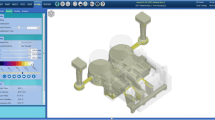Abstract
Oxide inclusions, which are created during the pouring process of aluminum alloys, are the main cause of leaks in castings. This contribution shows how the integration of autonomous design of experiments (DOEs) into the casting process simulation tool MAGMASOFT® provides the basis for the evaluation and subsequent optimization of process parameters in the melt transport and pouring process, which are responsible for the creation and distribution of oxide inclusions. At the same time, quality criteria describing the creation of oxides during the casting process of cylinder heads were evaluated quantitatively. The utilization of autonomous DOEs creates variations of the gating system and process parameters autonomously. It will be shown that autonomous DOEs are leading to optimized gating designs and process parameters resulting in a significant reduction of oxides in castings. The experiments supported by simulation were accompanied and validated by high-speed video technology and the PREFIL-measurement technology.

























Similar content being viewed by others
References
J. Campbell, Castings, 2nd edn. (Elsevier, Oxford, 2004)
K.D. Carlsson, C. Beckermann, in Modeling of Reoxidation Inclusion Formation During Filling of Steel Casting, Defect Formation, Detection, and Eliminating During Casting, Welding, and Solidification, TMS Materials Science and Technology Conference and Exhibition, September 2005, Pittsburgh, Pennsylvania, pp. 35–46
X. Yang, X. Huang, X. Dai, J. Campbell, J. Tatler, Numerical modelling of the entrainment of oxide film defects in filling of aluminum alloy casting. Int. J. Cast Metal Res. 17(6), 321–331 (2004)
J. Campbell, in The Modeling of Entrainment Defects During Casting, Simulation of aluminum shape casting processing: from alloy design to mechanical properties (The Minerals, Metals & Materials Society, 2006)
N.W. Lai, W.D. Griffiths, J. Campbell, Modeling of the Potential for Oxide Films Entrainment in Light Metal Alloy Castings. Modeling of Casting Welding and Advanced Solidification Processes (TMS, Warrendale, 2003)
J. Lin, M.A.R. Sharif, J.L. Hill, Numerical simulation of the movement, brake up and entrapment of oxide films during aluminum casting. Alum. Trans. 1, 71–78 (1999)
C. Reilly, Development of Quantitative Casting Quality Assessment Criteria Using Process Modelling. PhD Thesis, The University of Birmingham, 2010
L. Pavlak, Experimentelle und simulationstechnische Ursachenanalyse der Oxidbildung beim Zylinderkopfgießen. Dissertation, Shaker Verlag 2011
Author information
Authors and Affiliations
Corresponding author
Rights and permissions
About this article
Cite this article
Pavlak, L., Sturm, J.C. Reduction of Oxide Inclusions in Aluminum Cylinder Heads Through Autonomous Designs of Experiments. Inter Metalcast 11, 174–188 (2017). https://doi.org/10.1007/s40962-016-0096-5
Published:
Issue Date:
DOI: https://doi.org/10.1007/s40962-016-0096-5




